Comprehensive Management Accounting Report: Aspall Cyder Ltd Analysis
VerifiedAdded on 2021/02/19
|15
|4144
|50
Report
AI Summary
This report provides a comprehensive analysis of management accounting practices at Aspall Cyder Ltd, a UK-based cider and drinks manufacturer. The report begins with an introduction to management accounting systems, including cost accounting, inventory management, price optimization, and job order costing. It then details management accounting reporting, covering budget reports, accounts receivable reports, and inventory management reports. The core of the report delves into the application of costing methods, specifically marginal costing and absorption costing, with detailed examples and profit statements. Furthermore, the report explores planning tools and budgetary control, including sales, production, material usage, material purchase, cash, and flexible budgets. Finally, it examines the adaptation of management accounting in response to financial problems and financial governance, comparing the two approaches. The report concludes with a summary of the key findings and references used.
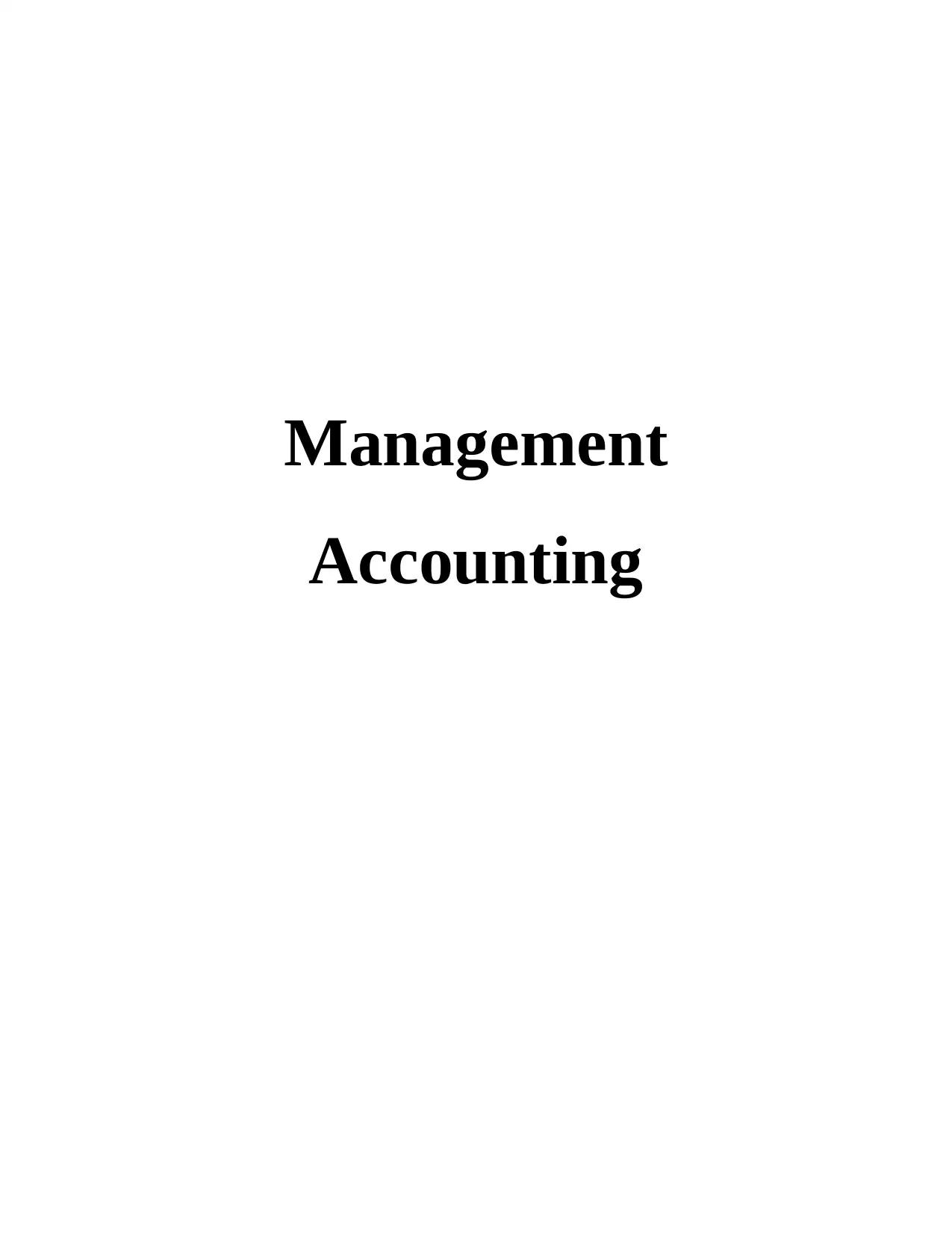
Management
Accounting
Accounting
Paraphrase This Document
Need a fresh take? Get an instant paraphrase of this document with our AI Paraphraser
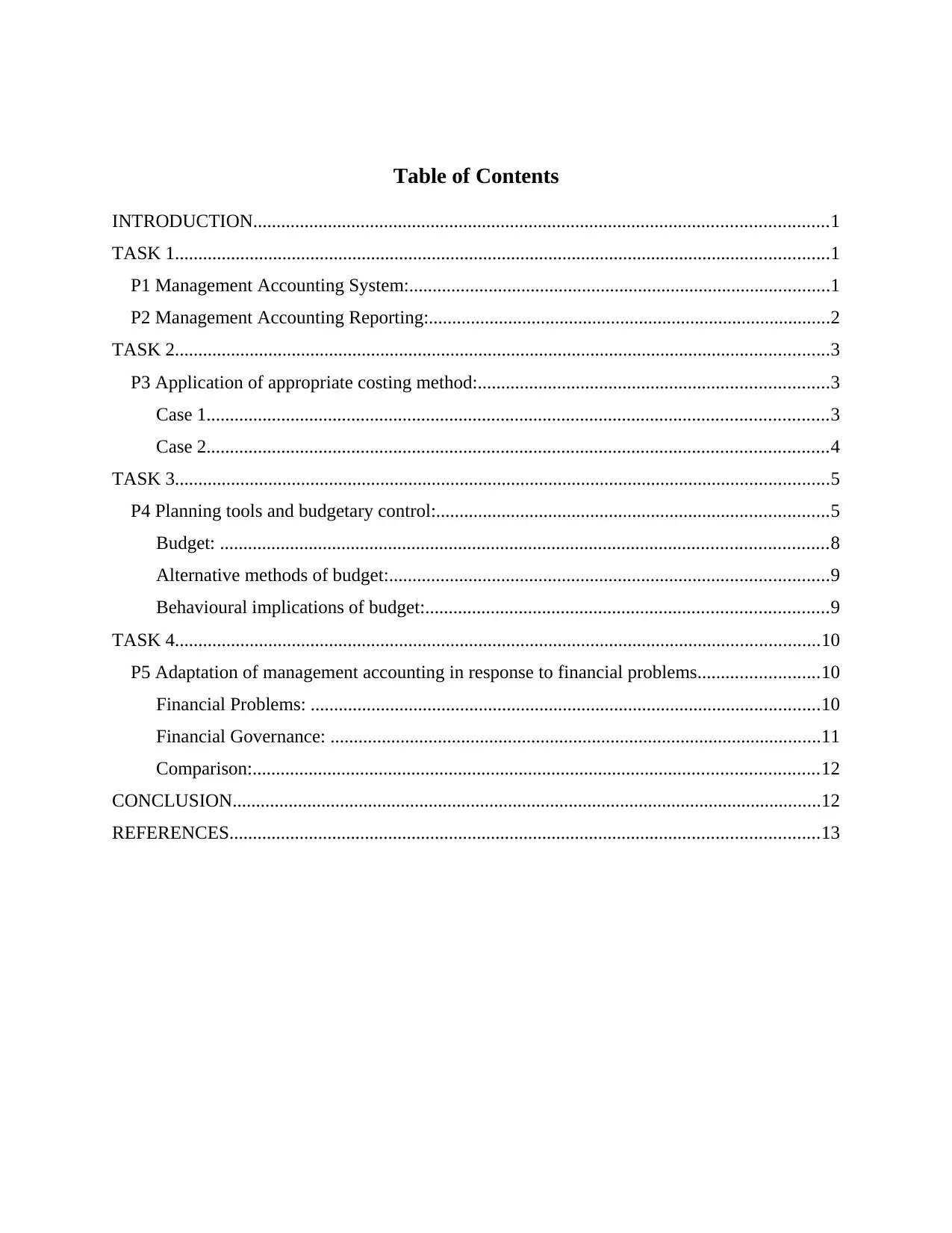
Table of Contents
INTRODUCTION...........................................................................................................................1
TASK 1............................................................................................................................................1
P1 Management Accounting System:..........................................................................................1
P2 Management Accounting Reporting:......................................................................................2
TASK 2............................................................................................................................................3
P3 Application of appropriate costing method:...........................................................................3
Case 1.....................................................................................................................................3
Case 2.....................................................................................................................................4
TASK 3............................................................................................................................................5
P4 Planning tools and budgetary control:....................................................................................5
Budget: ..................................................................................................................................8
Alternative methods of budget:..............................................................................................9
Behavioural implications of budget:......................................................................................9
TASK 4..........................................................................................................................................10
P5 Adaptation of management accounting in response to financial problems..........................10
Financial Problems: .............................................................................................................10
Financial Governance: .........................................................................................................11
Comparison:.........................................................................................................................12
CONCLUSION..............................................................................................................................12
REFERENCES..............................................................................................................................13
INTRODUCTION...........................................................................................................................1
TASK 1............................................................................................................................................1
P1 Management Accounting System:..........................................................................................1
P2 Management Accounting Reporting:......................................................................................2
TASK 2............................................................................................................................................3
P3 Application of appropriate costing method:...........................................................................3
Case 1.....................................................................................................................................3
Case 2.....................................................................................................................................4
TASK 3............................................................................................................................................5
P4 Planning tools and budgetary control:....................................................................................5
Budget: ..................................................................................................................................8
Alternative methods of budget:..............................................................................................9
Behavioural implications of budget:......................................................................................9
TASK 4..........................................................................................................................................10
P5 Adaptation of management accounting in response to financial problems..........................10
Financial Problems: .............................................................................................................10
Financial Governance: .........................................................................................................11
Comparison:.........................................................................................................................12
CONCLUSION..............................................................................................................................12
REFERENCES..............................................................................................................................13
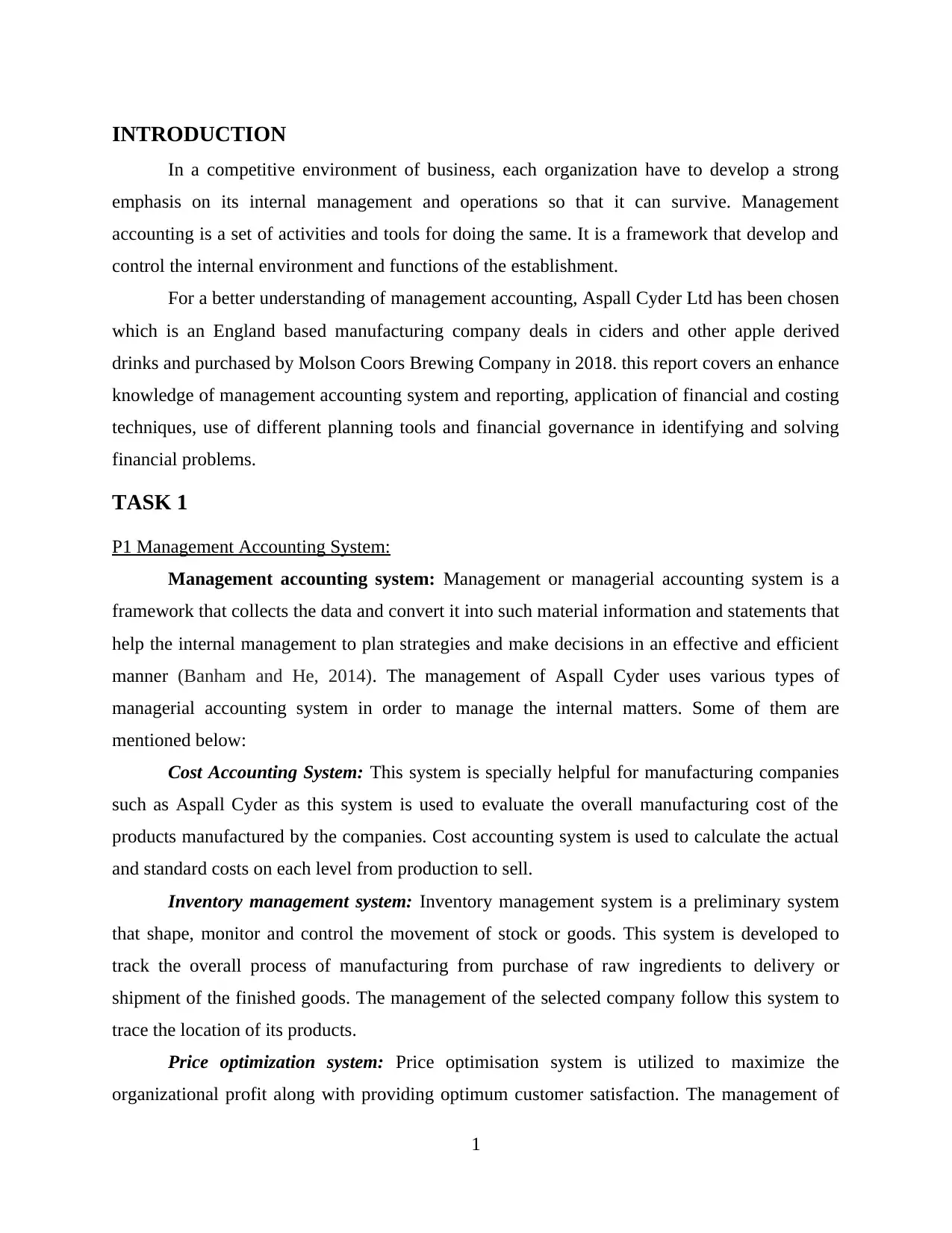
INTRODUCTION
In a competitive environment of business, each organization have to develop a strong
emphasis on its internal management and operations so that it can survive. Management
accounting is a set of activities and tools for doing the same. It is a framework that develop and
control the internal environment and functions of the establishment.
For a better understanding of management accounting, Aspall Cyder Ltd has been chosen
which is an England based manufacturing company deals in ciders and other apple derived
drinks and purchased by Molson Coors Brewing Company in 2018. this report covers an enhance
knowledge of management accounting system and reporting, application of financial and costing
techniques, use of different planning tools and financial governance in identifying and solving
financial problems.
TASK 1
P1 Management Accounting System:
Management accounting system: Management or managerial accounting system is a
framework that collects the data and convert it into such material information and statements that
help the internal management to plan strategies and make decisions in an effective and efficient
manner (Banham and He, 2014). The management of Aspall Cyder uses various types of
managerial accounting system in order to manage the internal matters. Some of them are
mentioned below:
Cost Accounting System: This system is specially helpful for manufacturing companies
such as Aspall Cyder as this system is used to evaluate the overall manufacturing cost of the
products manufactured by the companies. Cost accounting system is used to calculate the actual
and standard costs on each level from production to sell.
Inventory management system: Inventory management system is a preliminary system
that shape, monitor and control the movement of stock or goods. This system is developed to
track the overall process of manufacturing from purchase of raw ingredients to delivery or
shipment of the finished goods. The management of the selected company follow this system to
trace the location of its products.
Price optimization system: Price optimisation system is utilized to maximize the
organizational profit along with providing optimum customer satisfaction. The management of
1
In a competitive environment of business, each organization have to develop a strong
emphasis on its internal management and operations so that it can survive. Management
accounting is a set of activities and tools for doing the same. It is a framework that develop and
control the internal environment and functions of the establishment.
For a better understanding of management accounting, Aspall Cyder Ltd has been chosen
which is an England based manufacturing company deals in ciders and other apple derived
drinks and purchased by Molson Coors Brewing Company in 2018. this report covers an enhance
knowledge of management accounting system and reporting, application of financial and costing
techniques, use of different planning tools and financial governance in identifying and solving
financial problems.
TASK 1
P1 Management Accounting System:
Management accounting system: Management or managerial accounting system is a
framework that collects the data and convert it into such material information and statements that
help the internal management to plan strategies and make decisions in an effective and efficient
manner (Banham and He, 2014). The management of Aspall Cyder uses various types of
managerial accounting system in order to manage the internal matters. Some of them are
mentioned below:
Cost Accounting System: This system is specially helpful for manufacturing companies
such as Aspall Cyder as this system is used to evaluate the overall manufacturing cost of the
products manufactured by the companies. Cost accounting system is used to calculate the actual
and standard costs on each level from production to sell.
Inventory management system: Inventory management system is a preliminary system
that shape, monitor and control the movement of stock or goods. This system is developed to
track the overall process of manufacturing from purchase of raw ingredients to delivery or
shipment of the finished goods. The management of the selected company follow this system to
trace the location of its products.
Price optimization system: Price optimisation system is utilized to maximize the
organizational profit along with providing optimum customer satisfaction. The management of
1
⊘ This is a preview!⊘
Do you want full access?
Subscribe today to unlock all pages.

Trusted by 1+ million students worldwide
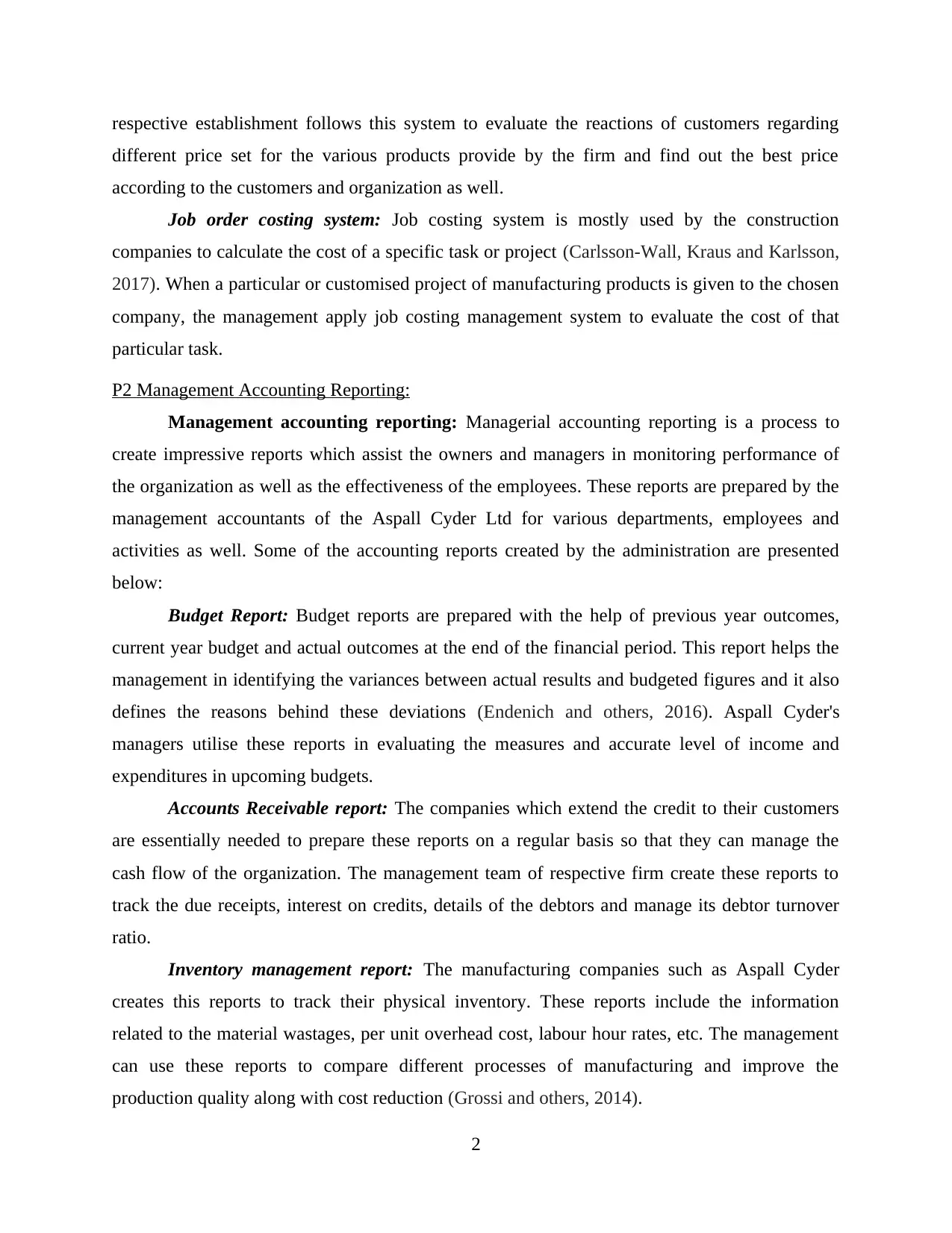
respective establishment follows this system to evaluate the reactions of customers regarding
different price set for the various products provide by the firm and find out the best price
according to the customers and organization as well.
Job order costing system: Job costing system is mostly used by the construction
companies to calculate the cost of a specific task or project (Carlsson-Wall, Kraus and Karlsson,
2017). When a particular or customised project of manufacturing products is given to the chosen
company, the management apply job costing management system to evaluate the cost of that
particular task.
P2 Management Accounting Reporting:
Management accounting reporting: Managerial accounting reporting is a process to
create impressive reports which assist the owners and managers in monitoring performance of
the organization as well as the effectiveness of the employees. These reports are prepared by the
management accountants of the Aspall Cyder Ltd for various departments, employees and
activities as well. Some of the accounting reports created by the administration are presented
below:
Budget Report: Budget reports are prepared with the help of previous year outcomes,
current year budget and actual outcomes at the end of the financial period. This report helps the
management in identifying the variances between actual results and budgeted figures and it also
defines the reasons behind these deviations (Endenich and others, 2016). Aspall Cyder's
managers utilise these reports in evaluating the measures and accurate level of income and
expenditures in upcoming budgets.
Accounts Receivable report: The companies which extend the credit to their customers
are essentially needed to prepare these reports on a regular basis so that they can manage the
cash flow of the organization. The management team of respective firm create these reports to
track the due receipts, interest on credits, details of the debtors and manage its debtor turnover
ratio.
Inventory management report: The manufacturing companies such as Aspall Cyder
creates this reports to track their physical inventory. These reports include the information
related to the material wastages, per unit overhead cost, labour hour rates, etc. The management
can use these reports to compare different processes of manufacturing and improve the
production quality along with cost reduction (Grossi and others, 2014).
2
different price set for the various products provide by the firm and find out the best price
according to the customers and organization as well.
Job order costing system: Job costing system is mostly used by the construction
companies to calculate the cost of a specific task or project (Carlsson-Wall, Kraus and Karlsson,
2017). When a particular or customised project of manufacturing products is given to the chosen
company, the management apply job costing management system to evaluate the cost of that
particular task.
P2 Management Accounting Reporting:
Management accounting reporting: Managerial accounting reporting is a process to
create impressive reports which assist the owners and managers in monitoring performance of
the organization as well as the effectiveness of the employees. These reports are prepared by the
management accountants of the Aspall Cyder Ltd for various departments, employees and
activities as well. Some of the accounting reports created by the administration are presented
below:
Budget Report: Budget reports are prepared with the help of previous year outcomes,
current year budget and actual outcomes at the end of the financial period. This report helps the
management in identifying the variances between actual results and budgeted figures and it also
defines the reasons behind these deviations (Endenich and others, 2016). Aspall Cyder's
managers utilise these reports in evaluating the measures and accurate level of income and
expenditures in upcoming budgets.
Accounts Receivable report: The companies which extend the credit to their customers
are essentially needed to prepare these reports on a regular basis so that they can manage the
cash flow of the organization. The management team of respective firm create these reports to
track the due receipts, interest on credits, details of the debtors and manage its debtor turnover
ratio.
Inventory management report: The manufacturing companies such as Aspall Cyder
creates this reports to track their physical inventory. These reports include the information
related to the material wastages, per unit overhead cost, labour hour rates, etc. The management
can use these reports to compare different processes of manufacturing and improve the
production quality along with cost reduction (Grossi and others, 2014).
2
Paraphrase This Document
Need a fresh take? Get an instant paraphrase of this document with our AI Paraphraser

TASK 2
P3 Application of appropriate costing method:
Cost: Cost is the value that is incurred by the seller in order to sale its products. Overall
expenses that are paid by the Aspall Cyder in the process of purchasing raw material to deliver
the products to the customers will be consider as the cost. There are various types of the cost
which are described as under:
Direct cost: Direct costs are an overhead that can be completely assigned to the
manufacturing of particular product. The examples of direct costs are labour wages, machine
hours, manufacturing overheads, etc.
Indirect cost: These are the costs that are not directly connected with the production
process hence not accountable to a cost project such as depreciation and administrative expenses.
Fixed cost: The costs which remains unchanged or irrelevant to the production process
and output level are known as fixed costs. Insurance charges, interest, salaries, rent, etc. are the
examples of fixed costs (Halaoua, Hamdi and Mejri, 2017).
Variable cost: The costs which varies or fluctuate with the level of production or unit of
products are called variable costs. If there is no production in the factory then there will be no
variable cost.
Case 1
Marginal costing: Marginal costing method is used to determine the maximum
production capacity of an organization. Basically, it is the minimum cost of production of an
extra unit. This method set off all the fixed cost against contribution.
Cost Card (Marginal Costing):
Particular £/unit
Direct Material £50
Direct Labour £15
Variable Production Overhead £5
Variable Selling Overheads £4
Marginal Cost £74
3
P3 Application of appropriate costing method:
Cost: Cost is the value that is incurred by the seller in order to sale its products. Overall
expenses that are paid by the Aspall Cyder in the process of purchasing raw material to deliver
the products to the customers will be consider as the cost. There are various types of the cost
which are described as under:
Direct cost: Direct costs are an overhead that can be completely assigned to the
manufacturing of particular product. The examples of direct costs are labour wages, machine
hours, manufacturing overheads, etc.
Indirect cost: These are the costs that are not directly connected with the production
process hence not accountable to a cost project such as depreciation and administrative expenses.
Fixed cost: The costs which remains unchanged or irrelevant to the production process
and output level are known as fixed costs. Insurance charges, interest, salaries, rent, etc. are the
examples of fixed costs (Halaoua, Hamdi and Mejri, 2017).
Variable cost: The costs which varies or fluctuate with the level of production or unit of
products are called variable costs. If there is no production in the factory then there will be no
variable cost.
Case 1
Marginal costing: Marginal costing method is used to determine the maximum
production capacity of an organization. Basically, it is the minimum cost of production of an
extra unit. This method set off all the fixed cost against contribution.
Cost Card (Marginal Costing):
Particular £/unit
Direct Material £50
Direct Labour £15
Variable Production Overhead £5
Variable Selling Overheads £4
Marginal Cost £74
3
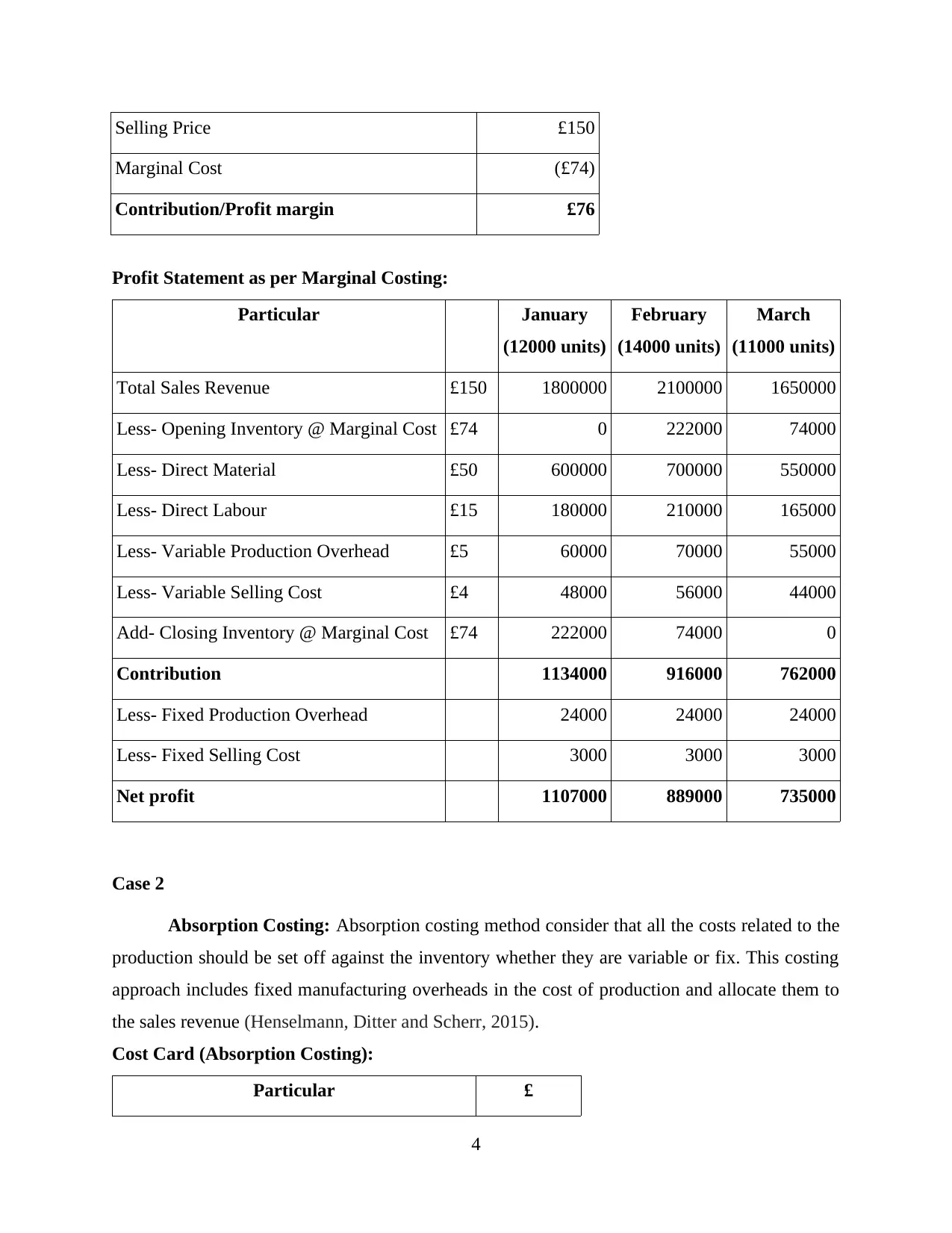
Selling Price £150
Marginal Cost (£74)
Contribution/Profit margin £76
Profit Statement as per Marginal Costing:
Particular January
(12000 units)
February
(14000 units)
March
(11000 units)
Total Sales Revenue £150 1800000 2100000 1650000
Less- Opening Inventory @ Marginal Cost £74 0 222000 74000
Less- Direct Material £50 600000 700000 550000
Less- Direct Labour £15 180000 210000 165000
Less- Variable Production Overhead £5 60000 70000 55000
Less- Variable Selling Cost £4 48000 56000 44000
Add- Closing Inventory @ Marginal Cost £74 222000 74000 0
Contribution 1134000 916000 762000
Less- Fixed Production Overhead 24000 24000 24000
Less- Fixed Selling Cost 3000 3000 3000
Net profit 1107000 889000 735000
Case 2
Absorption Costing: Absorption costing method consider that all the costs related to the
production should be set off against the inventory whether they are variable or fix. This costing
approach includes fixed manufacturing overheads in the cost of production and allocate them to
the sales revenue (Henselmann, Ditter and Scherr, 2015).
Cost Card (Absorption Costing):
Particular £
4
Marginal Cost (£74)
Contribution/Profit margin £76
Profit Statement as per Marginal Costing:
Particular January
(12000 units)
February
(14000 units)
March
(11000 units)
Total Sales Revenue £150 1800000 2100000 1650000
Less- Opening Inventory @ Marginal Cost £74 0 222000 74000
Less- Direct Material £50 600000 700000 550000
Less- Direct Labour £15 180000 210000 165000
Less- Variable Production Overhead £5 60000 70000 55000
Less- Variable Selling Cost £4 48000 56000 44000
Add- Closing Inventory @ Marginal Cost £74 222000 74000 0
Contribution 1134000 916000 762000
Less- Fixed Production Overhead 24000 24000 24000
Less- Fixed Selling Cost 3000 3000 3000
Net profit 1107000 889000 735000
Case 2
Absorption Costing: Absorption costing method consider that all the costs related to the
production should be set off against the inventory whether they are variable or fix. This costing
approach includes fixed manufacturing overheads in the cost of production and allocate them to
the sales revenue (Henselmann, Ditter and Scherr, 2015).
Cost Card (Absorption Costing):
Particular £
4
⊘ This is a preview!⊘
Do you want full access?
Subscribe today to unlock all pages.

Trusted by 1+ million students worldwide
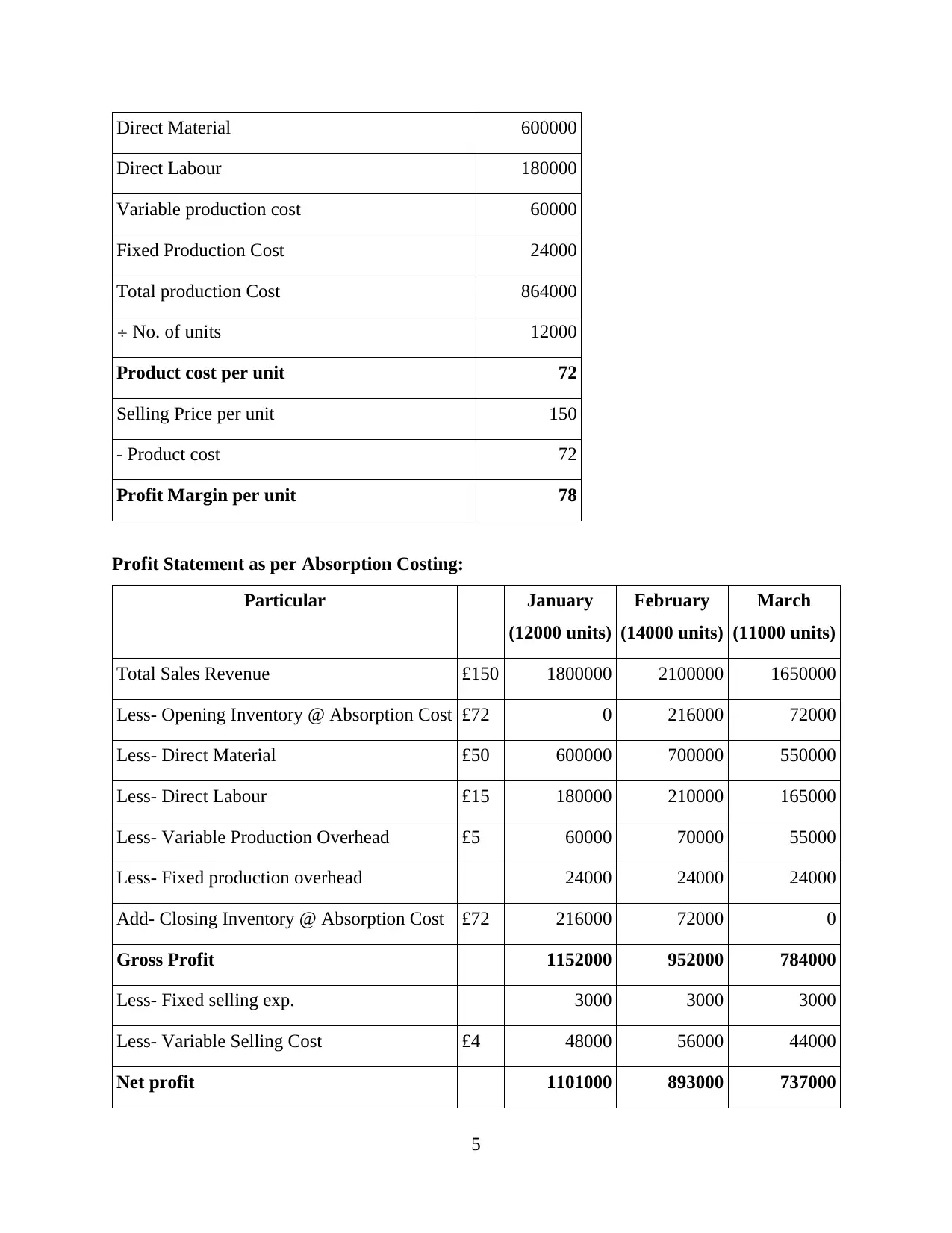
Direct Material 600000
Direct Labour 180000
Variable production cost 60000
Fixed Production Cost 24000
Total production Cost 864000
÷ No. of units 12000
Product cost per unit 72
Selling Price per unit 150
- Product cost 72
Profit Margin per unit 78
Profit Statement as per Absorption Costing:
Particular January
(12000 units)
February
(14000 units)
March
(11000 units)
Total Sales Revenue £150 1800000 2100000 1650000
Less- Opening Inventory @ Absorption Cost £72 0 216000 72000
Less- Direct Material £50 600000 700000 550000
Less- Direct Labour £15 180000 210000 165000
Less- Variable Production Overhead £5 60000 70000 55000
Less- Fixed production overhead 24000 24000 24000
Add- Closing Inventory @ Absorption Cost £72 216000 72000 0
Gross Profit 1152000 952000 784000
Less- Fixed selling exp. 3000 3000 3000
Less- Variable Selling Cost £4 48000 56000 44000
Net profit 1101000 893000 737000
5
Direct Labour 180000
Variable production cost 60000
Fixed Production Cost 24000
Total production Cost 864000
÷ No. of units 12000
Product cost per unit 72
Selling Price per unit 150
- Product cost 72
Profit Margin per unit 78
Profit Statement as per Absorption Costing:
Particular January
(12000 units)
February
(14000 units)
March
(11000 units)
Total Sales Revenue £150 1800000 2100000 1650000
Less- Opening Inventory @ Absorption Cost £72 0 216000 72000
Less- Direct Material £50 600000 700000 550000
Less- Direct Labour £15 180000 210000 165000
Less- Variable Production Overhead £5 60000 70000 55000
Less- Fixed production overhead 24000 24000 24000
Add- Closing Inventory @ Absorption Cost £72 216000 72000 0
Gross Profit 1152000 952000 784000
Less- Fixed selling exp. 3000 3000 3000
Less- Variable Selling Cost £4 48000 56000 44000
Net profit 1101000 893000 737000
5
Paraphrase This Document
Need a fresh take? Get an instant paraphrase of this document with our AI Paraphraser
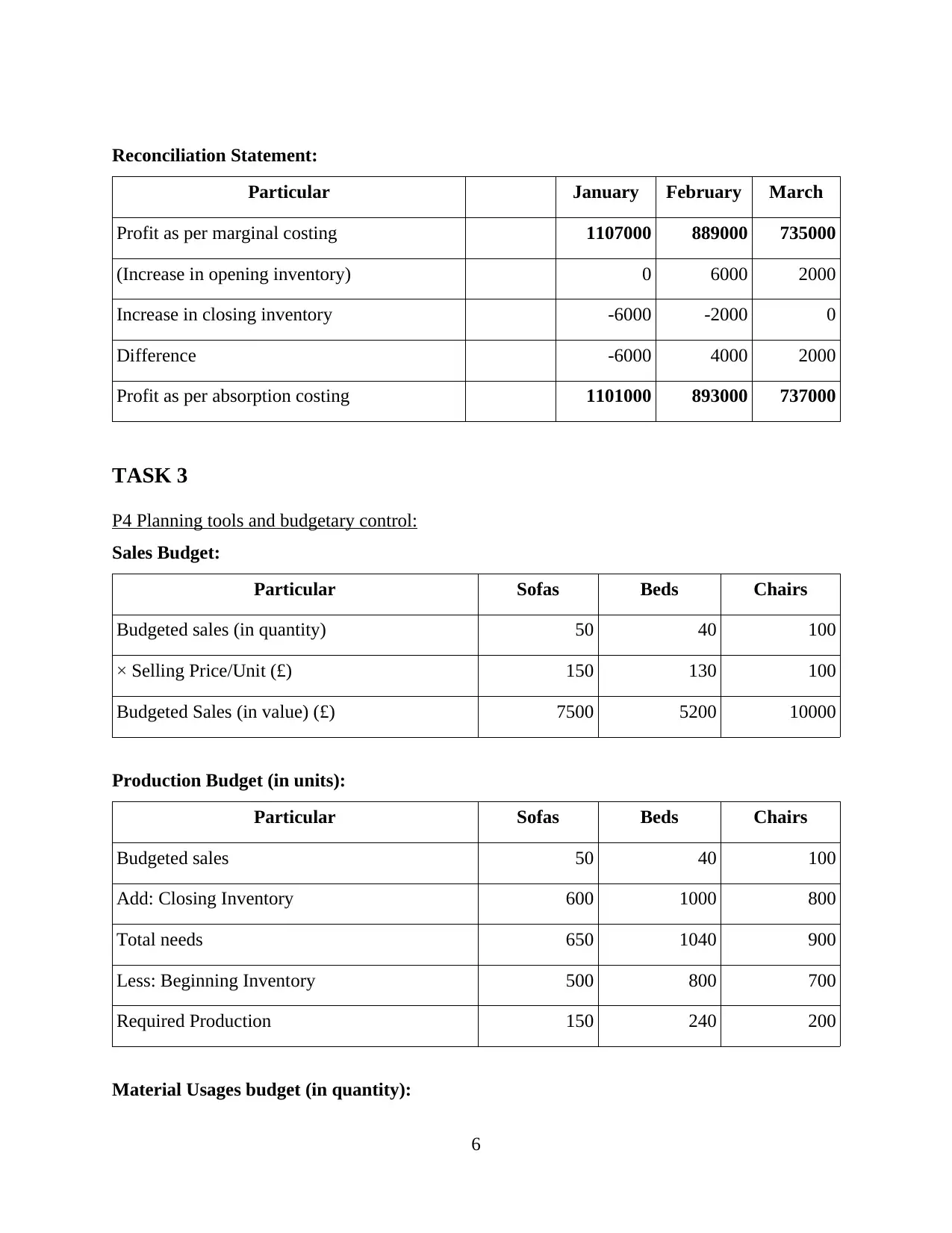
Reconciliation Statement:
Particular January February March
Profit as per marginal costing 1107000 889000 735000
(Increase in opening inventory) 0 6000 2000
Increase in closing inventory -6000 -2000 0
Difference -6000 4000 2000
Profit as per absorption costing 1101000 893000 737000
TASK 3
P4 Planning tools and budgetary control:
Sales Budget:
Particular Sofas Beds Chairs
Budgeted sales (in quantity) 50 40 100
× Selling Price/Unit (£) 150 130 100
Budgeted Sales (in value) (£) 7500 5200 10000
Production Budget (in units):
Particular Sofas Beds Chairs
Budgeted sales 50 40 100
Add: Closing Inventory 600 1000 800
Total needs 650 1040 900
Less: Beginning Inventory 500 800 700
Required Production 150 240 200
Material Usages budget (in quantity):
6
Particular January February March
Profit as per marginal costing 1107000 889000 735000
(Increase in opening inventory) 0 6000 2000
Increase in closing inventory -6000 -2000 0
Difference -6000 4000 2000
Profit as per absorption costing 1101000 893000 737000
TASK 3
P4 Planning tools and budgetary control:
Sales Budget:
Particular Sofas Beds Chairs
Budgeted sales (in quantity) 50 40 100
× Selling Price/Unit (£) 150 130 100
Budgeted Sales (in value) (£) 7500 5200 10000
Production Budget (in units):
Particular Sofas Beds Chairs
Budgeted sales 50 40 100
Add: Closing Inventory 600 1000 800
Total needs 650 1040 900
Less: Beginning Inventory 500 800 700
Required Production 150 240 200
Material Usages budget (in quantity):
6

Particular Woods
(kg)
Varnish
(ltr)
Woods
(kg)
Varnish
(ltr)
Woods
(kg)
Varnish
(ltr)
Budgeted Production in Units 150 240 200
× DM Required per Unit 12 4 10 4 5 2
DM Required for Production 1800 600 2400 960 1000 400
Material Purchase Budget (quantity & value):
Particular Woods Varnish
In quantity In Value
(8 £/Kg)
In quantity In Value
(4 £/litres)
Total Direct Material Required 5200 41600 1960 7840
Add: Closing DM 8000 64000 9000 36000
Less: Opening DM 11000 88000 10000 40000
Directed Material Purchased 2200 17600 960 3840
Working Note:
Total Direct material (Woods) = 1800+2400+1000 = 5200
Total Direct material (Varnish) = 600+960+400 = 1960
Cash Budget:
Particular April may June
Opening balance 25000 53000 81000
Add: Cash Receipts
Cash Sales 23000 25000 30000
Cash received from customers (Credit Sales) 60000 69000 75000
Total Cash inflow 108000 147000 186000
Less: Cash Payments
7
(kg)
Varnish
(ltr)
Woods
(kg)
Varnish
(ltr)
Woods
(kg)
Varnish
(ltr)
Budgeted Production in Units 150 240 200
× DM Required per Unit 12 4 10 4 5 2
DM Required for Production 1800 600 2400 960 1000 400
Material Purchase Budget (quantity & value):
Particular Woods Varnish
In quantity In Value
(8 £/Kg)
In quantity In Value
(4 £/litres)
Total Direct Material Required 5200 41600 1960 7840
Add: Closing DM 8000 64000 9000 36000
Less: Opening DM 11000 88000 10000 40000
Directed Material Purchased 2200 17600 960 3840
Working Note:
Total Direct material (Woods) = 1800+2400+1000 = 5200
Total Direct material (Varnish) = 600+960+400 = 1960
Cash Budget:
Particular April may June
Opening balance 25000 53000 81000
Add: Cash Receipts
Cash Sales 23000 25000 30000
Cash received from customers (Credit Sales) 60000 69000 75000
Total Cash inflow 108000 147000 186000
Less: Cash Payments
7
⊘ This is a preview!⊘
Do you want full access?
Subscribe today to unlock all pages.

Trusted by 1+ million students worldwide
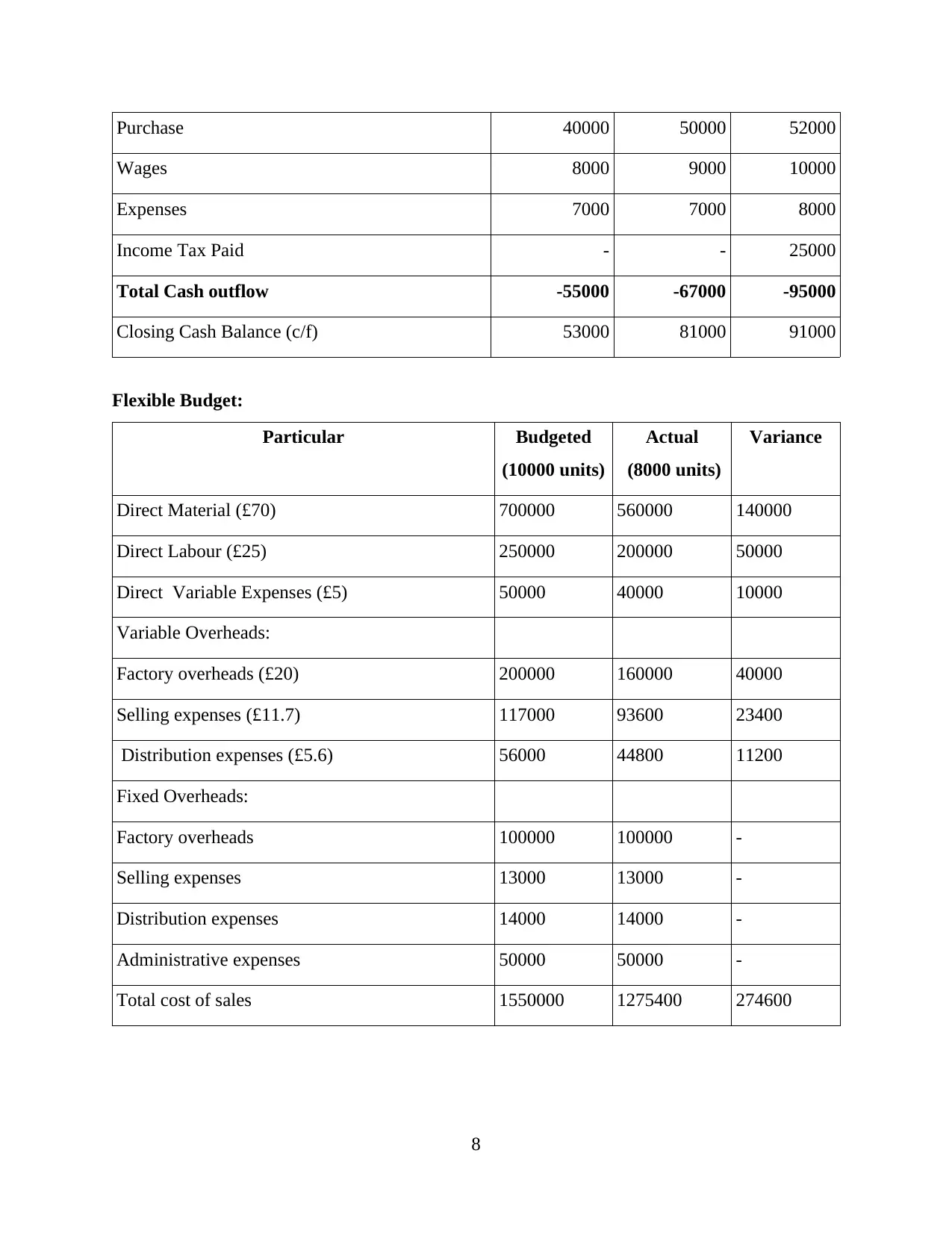
Purchase 40000 50000 52000
Wages 8000 9000 10000
Expenses 7000 7000 8000
Income Tax Paid - - 25000
Total Cash outflow -55000 -67000 -95000
Closing Cash Balance (c/f) 53000 81000 91000
Flexible Budget:
Particular Budgeted
(10000 units)
Actual
(8000 units)
Variance
Direct Material (£70) 700000 560000 140000
Direct Labour (£25) 250000 200000 50000
Direct Variable Expenses (£5) 50000 40000 10000
Variable Overheads:
Factory overheads (£20) 200000 160000 40000
Selling expenses (£11.7) 117000 93600 23400
Distribution expenses (£5.6) 56000 44800 11200
Fixed Overheads:
Factory overheads 100000 100000 -
Selling expenses 13000 13000 -
Distribution expenses 14000 14000 -
Administrative expenses 50000 50000 -
Total cost of sales 1550000 1275400 274600
8
Wages 8000 9000 10000
Expenses 7000 7000 8000
Income Tax Paid - - 25000
Total Cash outflow -55000 -67000 -95000
Closing Cash Balance (c/f) 53000 81000 91000
Flexible Budget:
Particular Budgeted
(10000 units)
Actual
(8000 units)
Variance
Direct Material (£70) 700000 560000 140000
Direct Labour (£25) 250000 200000 50000
Direct Variable Expenses (£5) 50000 40000 10000
Variable Overheads:
Factory overheads (£20) 200000 160000 40000
Selling expenses (£11.7) 117000 93600 23400
Distribution expenses (£5.6) 56000 44800 11200
Fixed Overheads:
Factory overheads 100000 100000 -
Selling expenses 13000 13000 -
Distribution expenses 14000 14000 -
Administrative expenses 50000 50000 -
Total cost of sales 1550000 1275400 274600
8
Paraphrase This Document
Need a fresh take? Get an instant paraphrase of this document with our AI Paraphraser
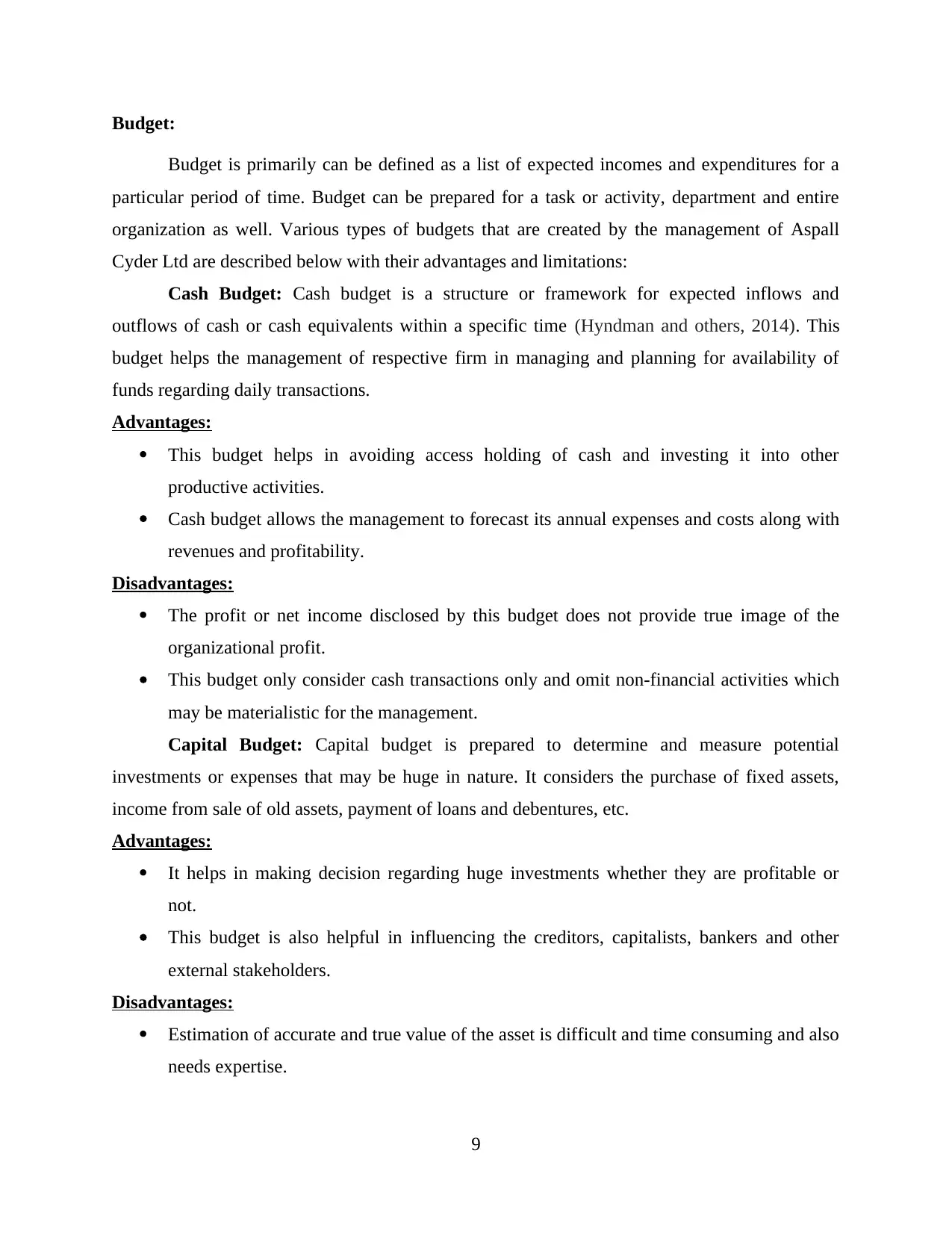
Budget:
Budget is primarily can be defined as a list of expected incomes and expenditures for a
particular period of time. Budget can be prepared for a task or activity, department and entire
organization as well. Various types of budgets that are created by the management of Aspall
Cyder Ltd are described below with their advantages and limitations:
Cash Budget: Cash budget is a structure or framework for expected inflows and
outflows of cash or cash equivalents within a specific time (Hyndman and others, 2014). This
budget helps the management of respective firm in managing and planning for availability of
funds regarding daily transactions.
Advantages:
This budget helps in avoiding access holding of cash and investing it into other
productive activities.
Cash budget allows the management to forecast its annual expenses and costs along with
revenues and profitability.
Disadvantages:
The profit or net income disclosed by this budget does not provide true image of the
organizational profit.
This budget only consider cash transactions only and omit non-financial activities which
may be materialistic for the management.
Capital Budget: Capital budget is prepared to determine and measure potential
investments or expenses that may be huge in nature. It considers the purchase of fixed assets,
income from sale of old assets, payment of loans and debentures, etc.
Advantages:
It helps in making decision regarding huge investments whether they are profitable or
not.
This budget is also helpful in influencing the creditors, capitalists, bankers and other
external stakeholders.
Disadvantages:
Estimation of accurate and true value of the asset is difficult and time consuming and also
needs expertise.
9
Budget is primarily can be defined as a list of expected incomes and expenditures for a
particular period of time. Budget can be prepared for a task or activity, department and entire
organization as well. Various types of budgets that are created by the management of Aspall
Cyder Ltd are described below with their advantages and limitations:
Cash Budget: Cash budget is a structure or framework for expected inflows and
outflows of cash or cash equivalents within a specific time (Hyndman and others, 2014). This
budget helps the management of respective firm in managing and planning for availability of
funds regarding daily transactions.
Advantages:
This budget helps in avoiding access holding of cash and investing it into other
productive activities.
Cash budget allows the management to forecast its annual expenses and costs along with
revenues and profitability.
Disadvantages:
The profit or net income disclosed by this budget does not provide true image of the
organizational profit.
This budget only consider cash transactions only and omit non-financial activities which
may be materialistic for the management.
Capital Budget: Capital budget is prepared to determine and measure potential
investments or expenses that may be huge in nature. It considers the purchase of fixed assets,
income from sale of old assets, payment of loans and debentures, etc.
Advantages:
It helps in making decision regarding huge investments whether they are profitable or
not.
This budget is also helpful in influencing the creditors, capitalists, bankers and other
external stakeholders.
Disadvantages:
Estimation of accurate and true value of the asset is difficult and time consuming and also
needs expertise.
9
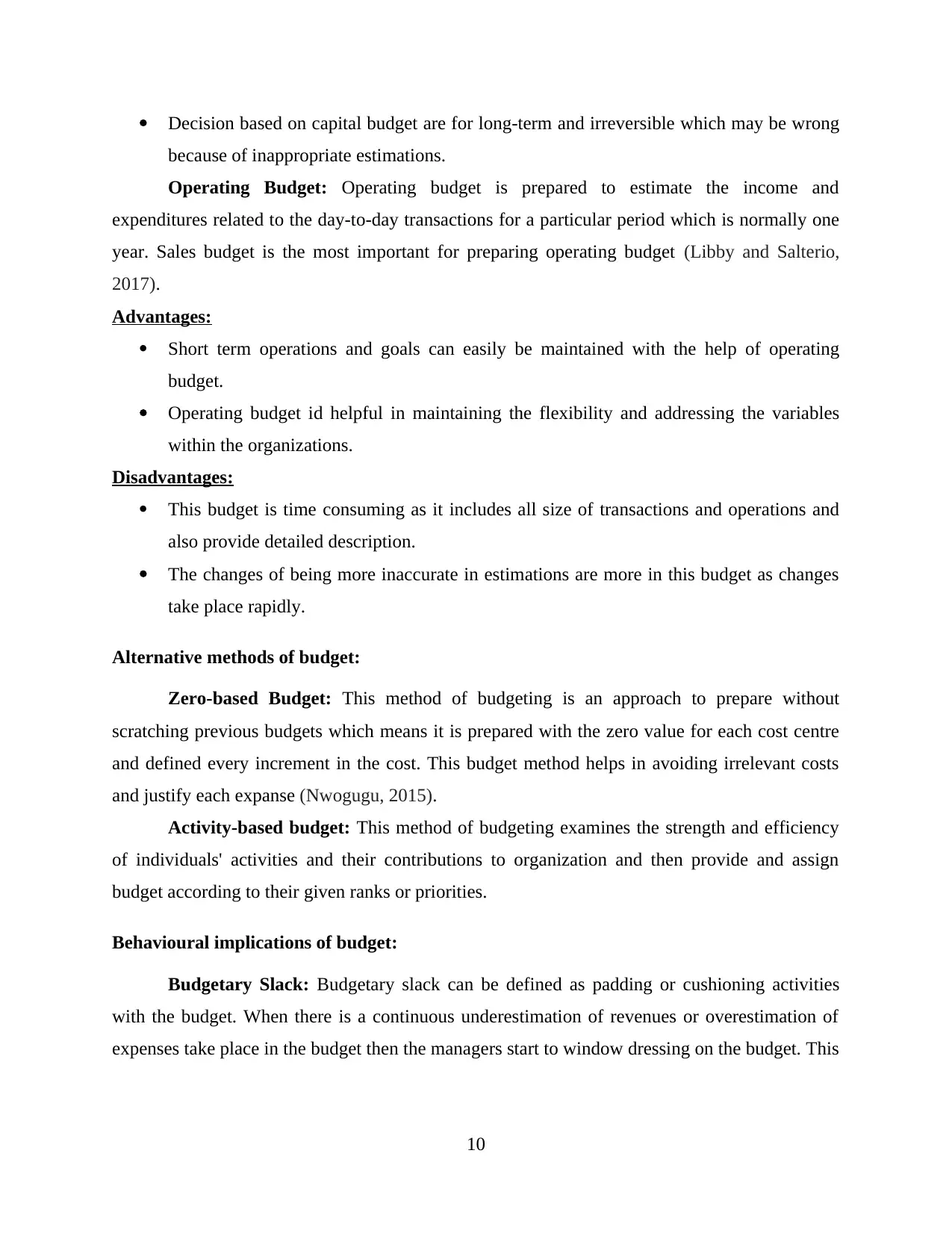
Decision based on capital budget are for long-term and irreversible which may be wrong
because of inappropriate estimations.
Operating Budget: Operating budget is prepared to estimate the income and
expenditures related to the day-to-day transactions for a particular period which is normally one
year. Sales budget is the most important for preparing operating budget (Libby and Salterio,
2017).
Advantages:
Short term operations and goals can easily be maintained with the help of operating
budget.
Operating budget id helpful in maintaining the flexibility and addressing the variables
within the organizations.
Disadvantages:
This budget is time consuming as it includes all size of transactions and operations and
also provide detailed description.
The changes of being more inaccurate in estimations are more in this budget as changes
take place rapidly.
Alternative methods of budget:
Zero-based Budget: This method of budgeting is an approach to prepare without
scratching previous budgets which means it is prepared with the zero value for each cost centre
and defined every increment in the cost. This budget method helps in avoiding irrelevant costs
and justify each expanse (Nwogugu, 2015).
Activity-based budget: This method of budgeting examines the strength and efficiency
of individuals' activities and their contributions to organization and then provide and assign
budget according to their given ranks or priorities.
Behavioural implications of budget:
Budgetary Slack: Budgetary slack can be defined as padding or cushioning activities
with the budget. When there is a continuous underestimation of revenues or overestimation of
expenses take place in the budget then the managers start to window dressing on the budget. This
10
because of inappropriate estimations.
Operating Budget: Operating budget is prepared to estimate the income and
expenditures related to the day-to-day transactions for a particular period which is normally one
year. Sales budget is the most important for preparing operating budget (Libby and Salterio,
2017).
Advantages:
Short term operations and goals can easily be maintained with the help of operating
budget.
Operating budget id helpful in maintaining the flexibility and addressing the variables
within the organizations.
Disadvantages:
This budget is time consuming as it includes all size of transactions and operations and
also provide detailed description.
The changes of being more inaccurate in estimations are more in this budget as changes
take place rapidly.
Alternative methods of budget:
Zero-based Budget: This method of budgeting is an approach to prepare without
scratching previous budgets which means it is prepared with the zero value for each cost centre
and defined every increment in the cost. This budget method helps in avoiding irrelevant costs
and justify each expanse (Nwogugu, 2015).
Activity-based budget: This method of budgeting examines the strength and efficiency
of individuals' activities and their contributions to organization and then provide and assign
budget according to their given ranks or priorities.
Behavioural implications of budget:
Budgetary Slack: Budgetary slack can be defined as padding or cushioning activities
with the budget. When there is a continuous underestimation of revenues or overestimation of
expenses take place in the budget then the managers start to window dressing on the budget. This
10
⊘ This is a preview!⊘
Do you want full access?
Subscribe today to unlock all pages.

Trusted by 1+ million students worldwide
1 out of 15
Related Documents
Your All-in-One AI-Powered Toolkit for Academic Success.
+13062052269
info@desklib.com
Available 24*7 on WhatsApp / Email
![[object Object]](/_next/static/media/star-bottom.7253800d.svg)
Unlock your academic potential
Copyright © 2020–2025 A2Z Services. All Rights Reserved. Developed and managed by ZUCOL.





